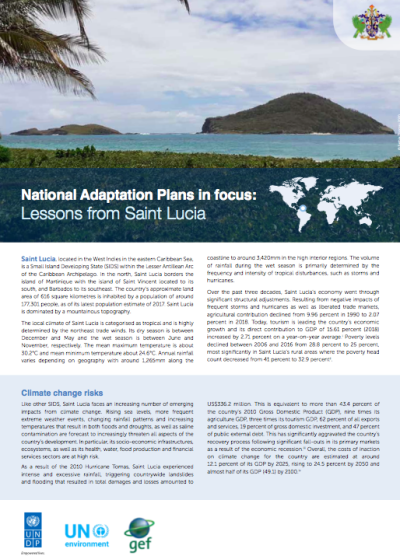Saint Lucia is a small island developing state located in the Eastern Caribbean with a population of approximately 170,000 people (USDS, 2010). St. Lucia is classified as a middle-income Small Island Developing State. It is of relatively recent volcanic origin with a rugged topography. It sits on an ancient volcanic ridge connecting Martinique to the north and St. Vincent to the south. It has an area of 616 square kilometers and an estimated population (2000) of 156,300.
As is typical of many such States, St. Lucia is characterized, inter alia, by: Limited mineral resources; An open fragile economy highly vulnerable to external economic factors; Limited human resources; Limited financial and technical resources. The country’s climate is characterized by a dry season (January to May) and a wet season (June to December), with a hurricane season lasting from late June until the end of November (MPDEH, 2003). The island is home to an impressive array of biodiversity, and approximately 35 per cent of its land area is covered by natural forest and rainforest (MPDEH, 2003). The island’s reef systems extend along its west and east coasts, with the healthiest and most diverse reefs being found along the central west coast. In general, the island’s reefs are subject to damage from land-based pollutants and sedimentation, which has threated near-shore fisheries (MPDEH, 2003).
The freshwater and mangrove wetlands of Saint Lucia are relatively small, although there are five species of mangrove found on the island (Tulsie, d’Auvergne and Barrow, 2001). The economy of Saint Lucia is dominated by tourism and banana production, with some activity from small-scale manufacturing (USDS, 2010).
Although a small island, St. Lucia has a relatively high level of biological and ecosystem diversity. It is home to numerous terrestrial and marine plants and animal species. Ecosystems include rainforest, coral reefs, mangals and sea grass beds. Population centres and economic activities, including tourism, are concentrated along the coast. These are therefore highly vulnerable to the anticipated effects of climate change such as sea-level rise.
Latest Publications
See allThis NAP in focus country briefing on the process to formulate and implement National Adaptation Plans in Saint Lucia considers firstly the…


